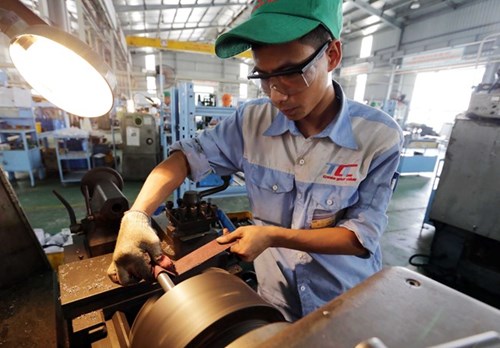At the event on ‘Implementing the development strategy for the mechanical engineering industry in the context of the Fourth Industrial Revolution’ held by the Ministry of Industry and Trade in Hanoi on September 5, participants shared experience and reviewed the sector's shortcomings and limitations while proposing solutions to its future development.
A report of the Vietnam Association of Mechanical Industry (VAMI) showed that total value of industrial production is estimated at USD 50 billion, with domestic production USD 16 billion.
This means the domestic mechanical industry meets only 32.5 percent of national demand, failing to meet the target of 45-50 percent set for 2010 in the development strategy approved in 2003.
According to VAMI President Dao Phan Long, after 20 years of development, Vietnam’s mechanical engineering companies are still employing technology 2.0 in equipment, work organization, production management as well as research and development, which has led to inferior products and human resources compared to regional countries.
    |
 |
|
A factory of the Tri Cuong Industrial Co., Ltd. at the Nguyen Khe Industrial Cluster in Dong Anh district, Hanoi |
He stressed both Government and local business should hold responsibility for this backwardness.
He said the policy system and State management for domestic mechanical engineering production was ineffective, unrealistic and incapable of protecting the domestic market. Meanwhile, local businesses have made spontaneous and extensive investments and failed to renovate technology and make market research.
The mechanical engineering industry is the backbone of the economy and supports the development of other industries, but local companies are still mainly processing structural steel frames, lacking high-value products such as electrical equipment, ships and automobile engineering.
According to mechanical specialist Nguyen Van Thu, State authorities are not fully aware of the importance of the industry. An industrialized economy cannot develop without a strong mechanical and heavy industry.
The world is standing on the brink of a new technological revolution (Industry 4.0) which will bring an upheaval in mechanical technology. This poses both challenges and opportunities for the local mechanical engineering industry.
The problem was to have a plan to invest in new production lines with state-of-the-art technology and train new mechanics and engineers to acquire new skills, Pham Hung, former General Director of Lilama Corporation.
Prime Minister Nguyen Xuan Phuc early this year approved the industry’s development strategy, requesting the adoption of advanced technology, producing high-quality products and joining the global value chain by 2035.
This has provided a new growing momentum for the industry, Ho Manh Tuan, Deputy General Director of the Vietnam Engine and Agricultural Machinery Corporation (VEAM) said. However, he called for Government incentives for investment in the industry, giving priority for big and large-scale manufacturing companies.
In the first phase, priority should be given to the production of input materials such as casting, forging and steel products which help the country seize control of materials and increase the localization rate, Tuan said.
According to VAMI, Vietnam needs a strategy to develop products which can compete with foreign goods such as manufacturing and assembling trucks, buses, non-standard equipment and structural steel.
Do Thang Hai, Deputy Minister of Industry and Trade, said the ministry will continue to work with other agencies and sectors to study and submit to the Government new policies encouraging the industry’s development and solving difficulties for enterprises.
It will build a decree on the development of the mechanical engineering industry, collaborating with the business community and associations to adjust the list of key mechanical products as well as simplifying procedures for this business.
Source: VNA